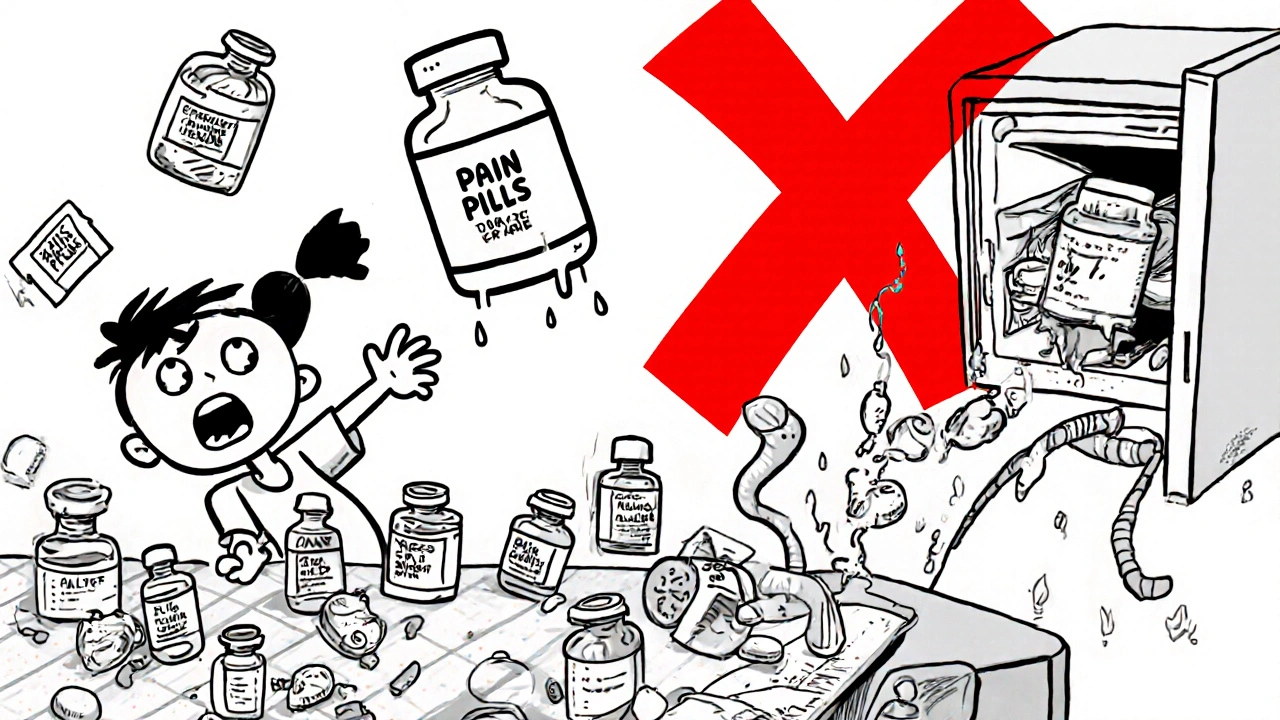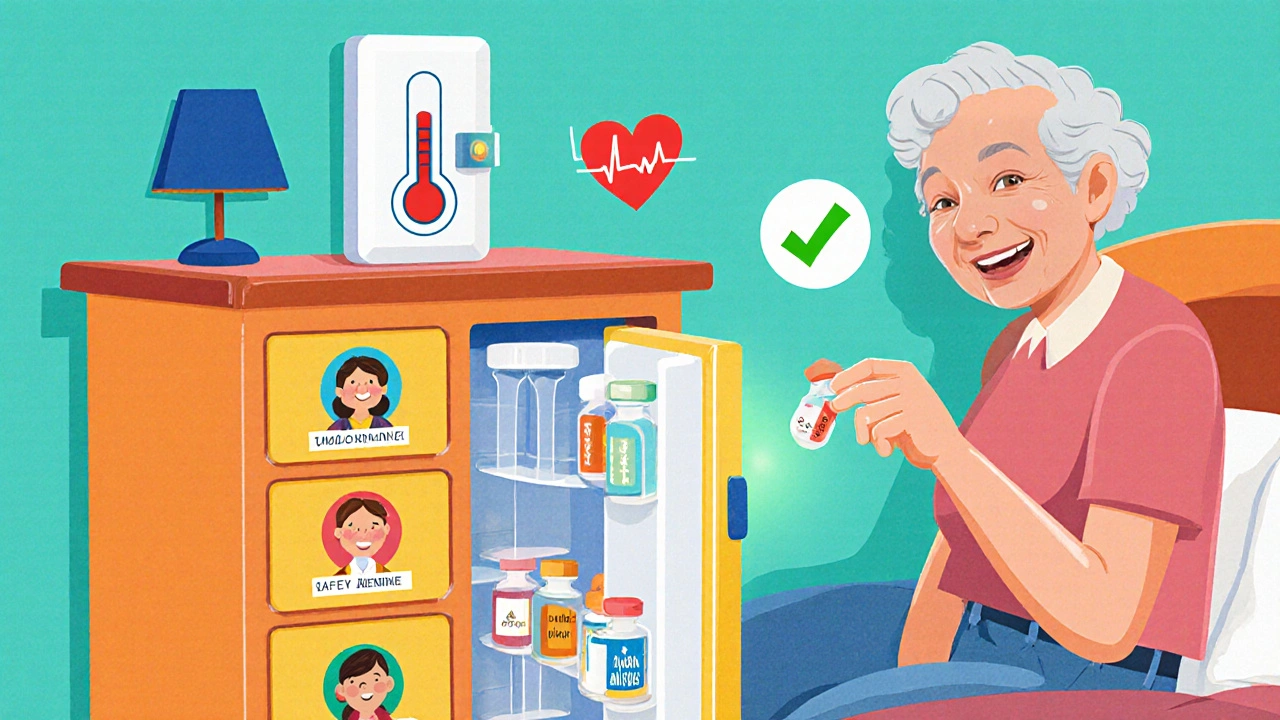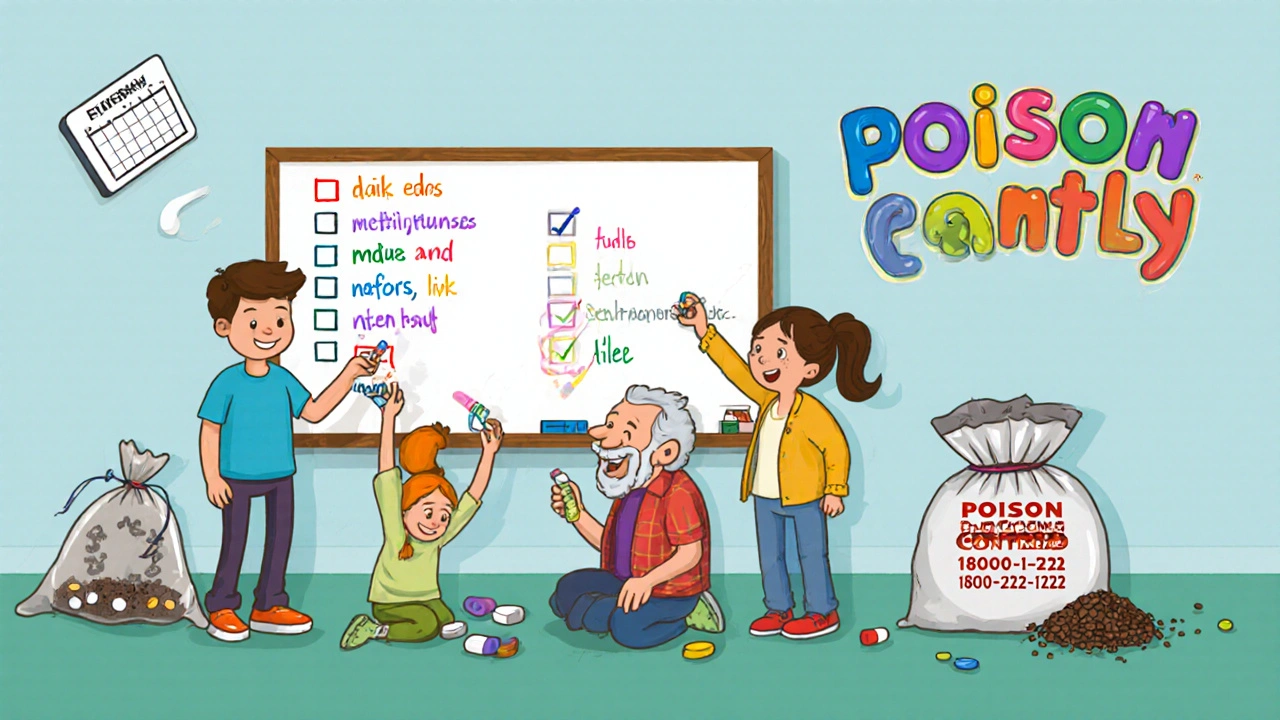
Living with others-whether it’s your aging parent, a sibling with chronic illness, or roommates in a multi-generational home-means sharing more than space. It means sharing responsibility for something that can be life-or-death: medication storage.
Every year, over 100,000 emergency room visits in the U.S. are linked to accidental medication exposure, especially in homes with kids, seniors, or people with cognitive challenges. And it’s not just about kids grabbing pills. It’s about insulin spoiling because it was left on the fridge door. It’s about someone else’s painkiller ending up in your medicine cabinet. It’s about confusion when two people take the same drug, but different doses.
Managing medication storage in shared spaces isn’t about being controlling. It’s about being smart, safe, and respectful. Here’s how to do it right.
Start by Cleaning Out the Clutter
Before you set up a system, get rid of what doesn’t belong. Old antibiotics from last winter’s cold. That bottle of ibuprofen you bought in 2022. The leftover opioids from a surgery five years ago. These aren’t just taking up space-they’re risks.
Check expiration dates on every bottle, pill pack, and liquid. The FDA says many medications lose potency after their expiration date, and some, like insulin or liquid antibiotics, can become dangerous if used past their prime. In one case documented by Eper.com, a senior’s blood sugar went wild because his insulin had been stored on the fridge door for weeks-temperature swings degraded it by 25%.
Dispose of expired or unused meds properly. Don’t flush them. Don’t toss them in the trash. Use a drug take-back program. Many pharmacies, including CVS and Walgreens, have drop-off bins. If none are nearby, mix pills with coffee grounds or cat litter, seal them in a bag, and throw them away. It’s messy, but it stops someone from digging through your trash.
Know Where Each Medication Belongs
Not all meds are created equal. Some need to be cold. Some need to be dry. Some need to be locked up like cash.
Refrigerated meds like insulin, certain antibiotics, and biologics must stay between 36°F and 46°F. That’s the center of the fridge-not the door. Door shelves swing 10-15 degrees daily. That’s enough to ruin sensitive drugs. If you’re sharing a fridge, use a small, labeled bin just for meds. Put it on the middle shelf, away from milk and leftovers.
Room-temperature meds like most pills, inhalers, and creams should go in a cool, dry place. Bathroom cabinets? Bad idea. Steam from showers and sinks can ruin tablets. A drawer in the bedroom, a closet shelf, or even a locked box on a nightstand works better.
Controlled substances-opioids, benzodiazepines, ADHD meds-must be locked. Period. The DEA and Joint Commission require it in care facilities. The same standard should apply at home. A simple lockbox with a combination or key, placed out of sight, is enough. Don’t leave them on the dresser. Don’t hide them under the mattress. That’s not secure-that’s tempting.
Designate a Central Storage Spot
One locked location for everyone’s meds. No exceptions.
In assisted living facilities, this is called a “medication room” or “med cart.” In a family home? It can be a single locked drawer in a bedroom, a wall-mounted safe, or a small cabinet with a childproof lock. The goal is simplicity: everyone knows where to go. No one has to guess.
Use clear, labeled containers. If you’re using a pill organizer, make sure each slot says the person’s name, the drug, and the time. If you’re keeping bottles, label them with the full name, dose, and purpose. “Pain pills” isn’t enough. “Oxycodone 5mg, take every 6 hours as needed for post-op pain” is.
One family in Houston switched from storing meds in five different places to one locked drawer-and saw their medication-related incidents drop from three per year to zero in six months.

Use Technology to Stay on Track
It’s 2025. You don’t have to rely on sticky notes and memory.
Smart medication safes are now available for under $80. Some, like the ones introduced by DosePacker in March 2024, track temperature, humidity, and who opens the box. They send alerts if someone tries to access meds outside scheduled times. They’re used in 112 care facilities across the U.S. and now available for home use.
For simpler needs, use a pill dispenser with alarms. The MedMinder or Hero devices remind users when to take meds and lock away the rest. They sync with apps so family members get alerts if a dose is missed.
Even a basic smartphone calendar with shared access can help. Set reminders for refill dates, expiration dates, and weekly med checks. Share the calendar with the person responsible for monitoring.
Document Everything
Professional care facilities keep Individualized Medication Administration Records (MARs). You don’t need that level of formality-but you do need a simple log.
Use a notebook or a free app like Medisafe or MyTherapy. Write down:
- Who takes what
- When they take it
- Any side effects
- When refills are due
One family kept a whiteboard on the fridge. Each person had a column. They checked off doses as they were taken. It reduced arguments, confusion, and near-misses. It took five minutes a day.
If someone is on insulin, blood pressure meds, or anticoagulants, this log can be lifesaving. Paramedics don’t have time to guess. They need to know what’s been taken-and what hasn’t.
Train Everyone in the Household
It’s not enough to lock the meds. Everyone needs to know why.
Teach kids: “These aren’t candy. Taking someone else’s pill can make you sick-or worse.”
Explain to seniors: “Your blood pressure pill isn’t the same as your grandson’s. Even if they look alike.”
For roommates: “I’m not being paranoid. I’m protecting my health. And yours.”
SeniorHelpers.com launched a free certification program in April 2025 for family caregivers. It’s a 30-minute online module that covers storage, labeling, disposal, and emergency response. Over 12,500 people completed it in the first month. You don’t need certification-but you do need to have the conversation.

What to Avoid
Here are the biggest mistakes people make:
- Storing meds in the bathroom
- Leaving pills on nightstands or kitchen counters
- Using one pillbox for multiple people
- Ignoring expiration dates
- Assuming “everyone knows” how to take their meds
- Not locking controlled substances
- Storing insulin on the fridge door
One study found that 67% of families in multi-generational homes had at least one medication-related incident in the past year. Over 40% of those involved children finding pills in bathroom cabinets. That’s preventable.
When Things Go Wrong
Accidents happen. A kid grabs a pill. A senior takes the wrong dose. A fridge breaks.
If someone takes the wrong med:
- Call Poison Control at 1-800-222-1222 immediately. Don’t wait for symptoms.
- Have the pill bottle or packaging ready. Tell them the name, dose, and time taken.
- Don’t induce vomiting unless instructed.
- Go to the ER if advised.
If a medication was exposed to heat or cold (e.g., left in a hot car or fridge failed), call the pharmacy. Some drugs can’t be used after temperature excursions-even if they look fine.
If a locked box is compromised, change the lock. Don’t wait for the next incident. Prevention is cheaper than the hospital bill.
It’s Not About Control. It’s About Care.
Managing medication storage in shared spaces isn’t about being the boss. It’s about making sure everyone stays healthy. It’s about peace of mind-for you, for your roommates, for your aging parents, for your kids.
The data is clear: homes with locked, labeled, temperature-appropriate storage have far fewer accidents. Professional facilities with strict systems have lower error rates. The tools are affordable. The knowledge is free.
You don’t need a medical degree. You just need to start.
Take five minutes today. Open the drawer. Check the labels. Lock it up. Write down what’s inside. Tell the people you live with why it matters.
That’s how safety starts.
Can I store my medications in the same cabinet as my vitamins and supplements?
Yes, but only if everything is clearly labeled and stored in a locked container. Vitamins and supplements aren’t regulated like prescription drugs, so mixing them with prescriptions increases the risk of confusion. Use separate compartments or containers inside the same locked box. Label each section with the person’s name and type of medication (e.g., “John - Prescriptions,” “Sarah - Vitamins”).
What if someone refuses to use a locked storage system?
Resistance is common, especially among seniors who feel it’s a loss of independence. Frame it as safety, not control. Say: “I’m not trying to take your freedom-I’m trying to make sure you don’t accidentally take someone else’s pill and end up in the hospital.” Offer to help them pick out a lockbox that looks nice and fits their space. Sometimes, just having a personal, easy-to-use box makes all the difference.
Do I need to refrigerate all my medications?
No. Only medications that specifically say “refrigerate” on the label need to be kept cold. Common ones include insulin, some antibiotics, eye drops, and biologic injections. Most pills, creams, and inhalers are fine at room temperature. Always check the original packaging or ask your pharmacist. Storing non-refrigerated meds in the fridge can cause moisture damage and reduce effectiveness.
How often should I check expiration dates?
Check every three months. That’s about the same frequency as changing your smoke detector batteries. Set a reminder on your phone for the first day of each season. Discard anything expired, discolored, or smelling odd. Some medications, like liquid antibiotics, can degrade within weeks after opening-even if the expiration date is months away.
Is it safe to keep my medications in my car or purse?
Not for long. Heat and cold damage meds. A car in summer can hit 140°F-enough to melt pills and ruin insulin. Cold winter temps can freeze liquids. If you need to carry meds with you, use a small insulated case and keep them with you, not in the glovebox. For daily use, a small pill organizer with a lock is better than leaving bottles in your purse or car.
What’s the best way to dispose of old medications?
Use a drug take-back program at a pharmacy or police station. If none are available, mix pills with cat litter or coffee grounds in a sealed plastic bag, then throw them in the trash. Never flush them unless the label says to. Flushing pollutes water systems and can harm wildlife. For syringes or sharps, use a dedicated sharps container-many pharmacies sell them for under $10.
Comments (10)
-
Henrik Stacke November 23, 2025
Let me tell you-this is the most coherent, life-saving guide I’ve read in years. I’ve seen my grandmother nearly overdose because her pills were in the bathroom cabinet, next to the toothpaste and that expired cough syrup from 2019. The fridge-door-insulin story? Chilling. We installed a lockbox last month. No more arguments. No more panic. Just quiet, safe compliance. Thank you for writing this like a human who’s been there.
-
Kezia Katherine Lewis November 24, 2025
As a cultural liaison in multigenerational households, I’ve observed that medication mismanagement is rarely about negligence-it’s about epistemic dissonance. The elderly perceive lockboxes as institutionalization; adolescents see labeled containers as infantilization. The solution isn’t just logistical-it’s semiotic. You must reframe storage as autonomy preservation, not control. The Houston case study is exemplary because it didn’t impose; it unified.
-
Manjistha Roy November 24, 2025
One locked drawer. One label. One system. No exceptions. This is not complicated. Why do we make it complicated? My mother used to hide her blood pressure pills under her pillow because she didn't trust the medicine cabinet. Now? She keeps them in a small wooden box on her nightstand with her name printed on it. She says it feels like her own little sanctuary. Simple. Safe. Smart.
-
Jennifer Skolney November 24, 2025
OMG YES. I just had to explain to my roommate why her ADHD meds can't just sit on the kitchen counter like snacks. I bought her a cute little lockbox with a combo lock-it looks like a jewelry box. She calls it her ‘medication safe’ now and even lets me check the refill dates. We’re not roommates anymore-we’re a healthcare team. 💪
-
Pramod Kumar November 25, 2025
Man, this hits different. Back home in Kerala, we used to stash pills in the spice rack-‘hidden where the gods wouldn’t find them.’ Now I laugh, but I’ve seen cousins end up in ERs because someone mistook a blood thinner for turmeric capsules. This guide? It’s not just advice-it’s a cultural antidote. Lock it. Label it. Love it. And for heaven’s sake, stop storing insulin next to the yogurt.
-
Lisa Lee November 27, 2025
Wow. Just wow. This is what happens when Americans overthink everything. In Canada, we just keep our meds in the bathroom. It’s fine. People are responsible. If your kid grabs a pill, maybe don’t let them wander around unsupervised? Also, why do you need an app to remind you to take your blood pressure meds? You’re not a robot.
-
Jennifer Shannon November 27, 2025
It’s funny, isn’t it? We live in a world where we can track our sleep cycles, monitor our heart rate via smartwatches, and get real-time updates on the weather in Tokyo-but we still treat our medications like ancient relics hidden under mattresses and behind toilet tanks. The real tragedy isn’t the expired insulin or the unlocked opioid bottle-it’s that we’ve normalized this chaos. We’ve made safety feel like an inconvenience. But safety isn’t a luxury; it’s the quietest, most consistent form of love we can offer the people we live with. And yes, it takes five minutes. But those five minutes? They’re the difference between a Tuesday and a funeral.
-
Suzan Wanjiru November 28, 2025
Use Medisafe. It’s free. Sync it with your family. Set refill alerts. Done. No lockbox needed if you’re disciplined. But if you’re not? Get one. Also stop storing meds in the car. Heat kills everything. Even aspirin. Seriously. Just read the label. It’s not that hard.
-
JD Mette November 29, 2025
I appreciate this. My dad has dementia. He used to take my mom’s blood thinner because they both had blue pills. We didn’t realize until she got dizzy at breakfast. Now everything’s in a locked drawer. I check it weekly. It’s not perfect. But it’s better. Thank you for saying it plainly.
-
Olanrewaju Jeph November 29, 2025
Excellent and meticulously structured. The integration of clinical best practices with domestic pragmatism is commendable. The emphasis on temperature integrity for biologics, coupled with the non-stigmatizing framing of controlled substance security, represents a paradigm shift in community-based pharmacovigilance. I have shared this with my caregiving cohort in Lagos. The whiteboard log suggestion is particularly elegant-low-tech, high-impact, and culturally adaptable. A model for global implementation.
